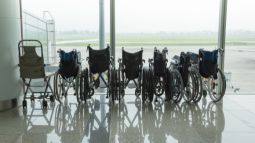In a single year, airlines mishandled more than 10,500 mobility devices, amounting to about 29 per day, according to data from the Department of Transportation. The risk of a wheelchair or other mobility device being damaged or lost, in addition to other stressors, are concerns of people with disabilities whenever they book a flight.
Flying as a wheelchair user can be daunting, but it is considered by many people with disabilities to be a key part of living a fulfilling and independent life. Good prior planning can make the experience less stressful. Here are tips for protecting your wheelchair from damage, your rights if your chair is damaged, and other info for flying as a wheelchair user.
1. Call the airline
When you’ve booked your flight, call the airline to remind them of when you’re flying with your wheelchair. Let them know the dimensions of your chair. If your wheelchair is powered, mention whether your battery is wet, dry, or gel cell. Mention any other needs such as an aisle chair to board the plane, assistance with transferring to your seat, and use of an extender belt, or upper torso harness.
2. Know your rights
Familiarize yourself with the Air Carrier Access Act, which states that it is illegal for airlines to discriminate based on disability. The ACAA requires airlines to help passengers with disabilities with boarding, deplaning, making connections and other accommodations. Additionally, you may want to sign up for TSA Pre-Check, which can be done within three to five days of your flight, to speed along the airport security screening process.
3. Purchase travel insurance
Travel insurance is essential for protecting yourself domestically and abroad. Allianz Global Assistance offers benefits such as emergency medical coverage, and reimbursement of certain nonrefundable expenses if your trip is canceled or delayed. Many people who are disabled or have a chronic illness assume they won’t be covered by travel insurance. But that’s not the case. Look for a travel insurance plan that includes the Pre-Existing Medical Condition Exclusion Waiver. (You can see a list of these plans here, along with a definition of “pre-existing medical condition.”) And our staff of travel experts is a phone call away with 24/7 assistance in case something goes wrong. Our agents can quickly connect you to local services and resources.
4. Plan for your comfort
If you are unable to assist with transfers, purchase a sling or lift to allow airport staff to help you to your seat comfortably. Additionally, bathroom needs are a practical consideration that is thoroughly and respectfully covered in the blog Have Wheelchair Will Travel.
5. What to pack
Just before you board, remove any parts of your wheelchair that could be damaged in transit – joystick, headrest, knee supports, etc. Consider supplying bubble wrap to protect your chair. Remove your cushion and place it on your plane seat. Store the removable parts in a bag and ask the flight attendant to stow the tote in the closet on the plane. In case of emergencies, pack a backpack with wheelchair repair items such as duct tape, allen wrenches and replacement screws.
6. Inspect your chair
When you land, remember to check your wheelchair for damage when it’s returned to you. If there’s a problem, ask the gate attendant to file a report. Then head down to baggage claim and request a Complaint Resolution Official, who will file an additional report and provide a reference number. Airlines are legally responsible for repairing and placing chairs and other mobility devices up to the original cost of the item.
Get a quote today to find out how Allianz Global Assistance can make your travels blissfully stress-free.
Related Articles









Share this Page